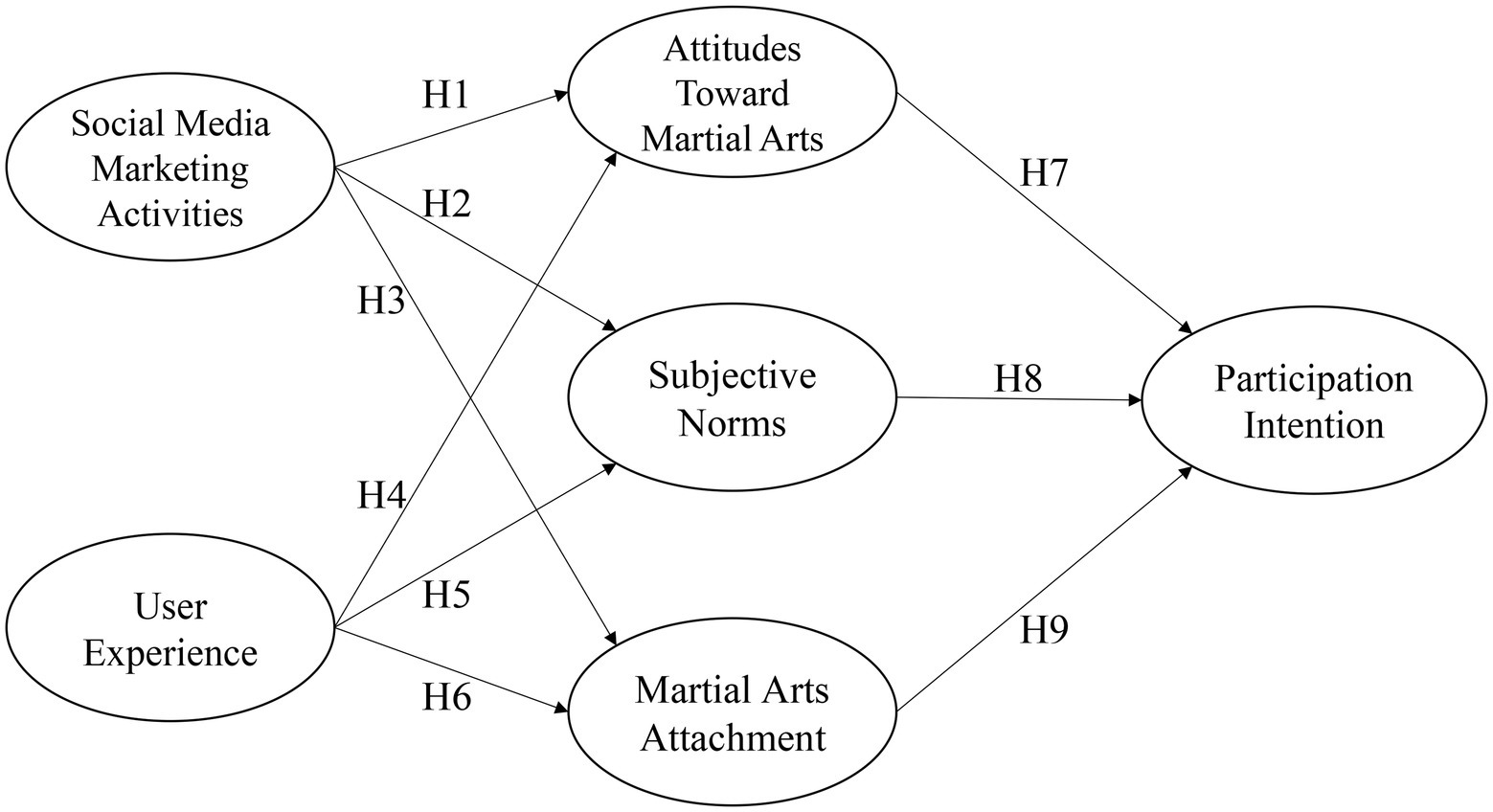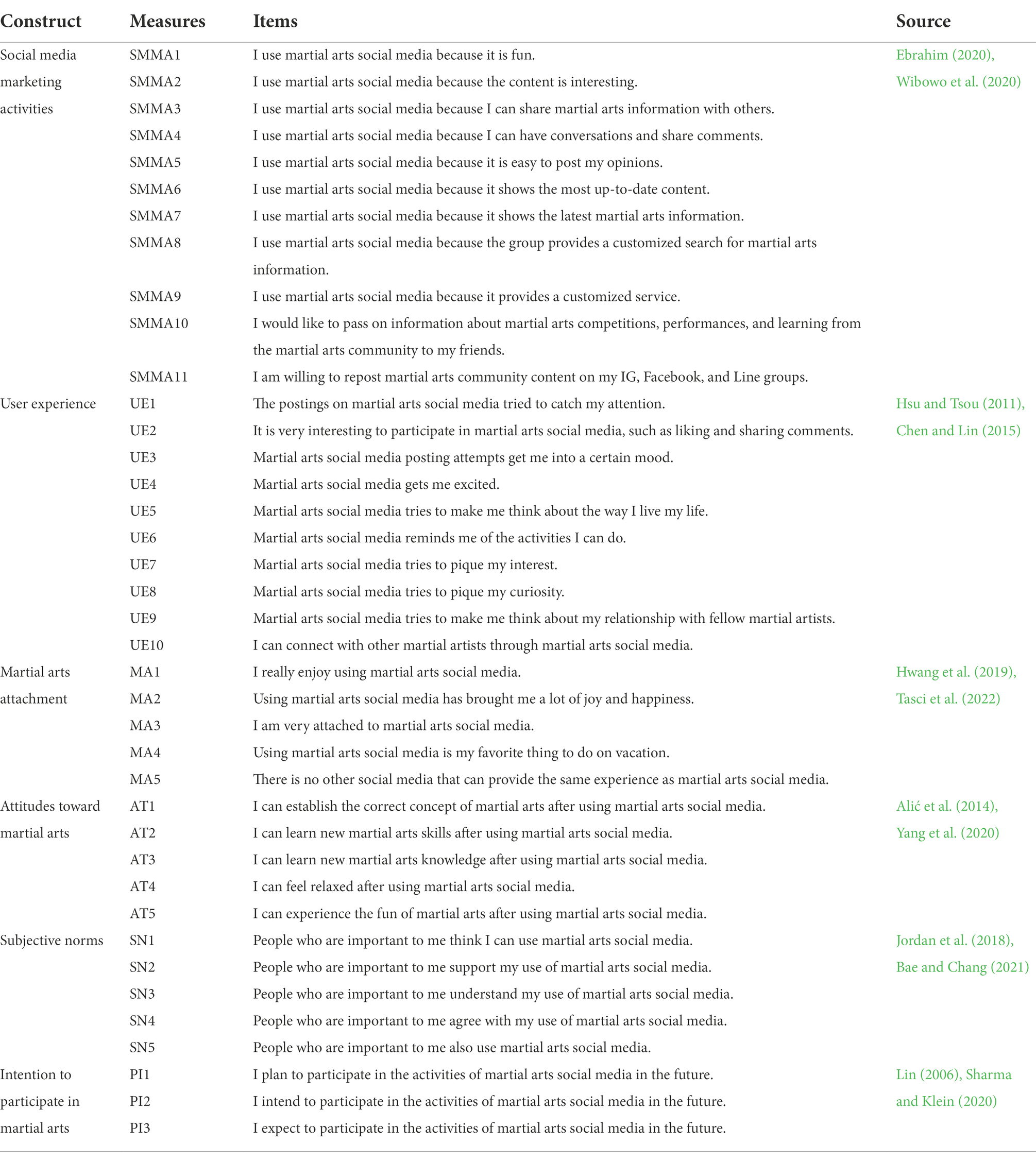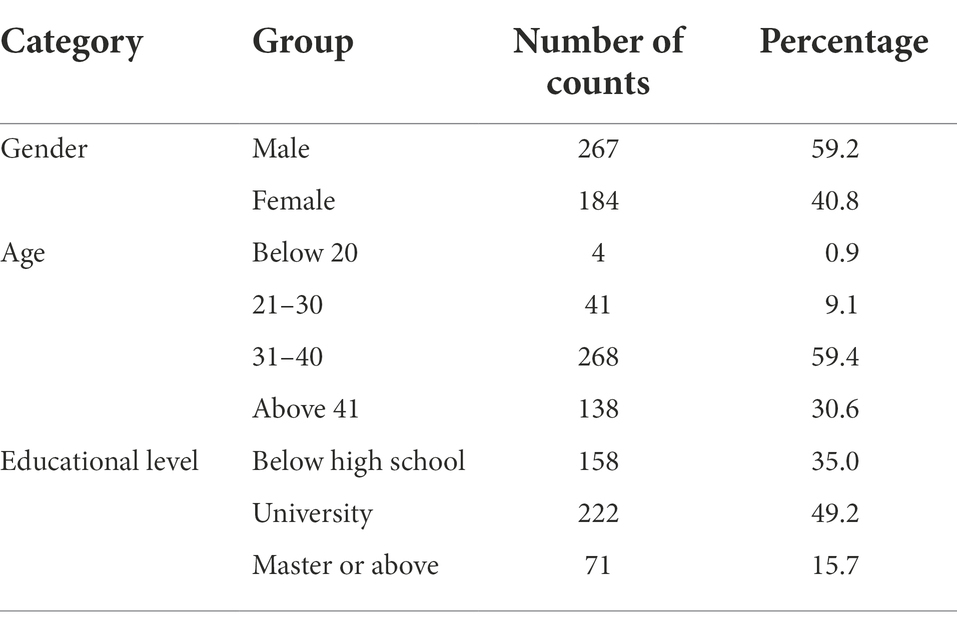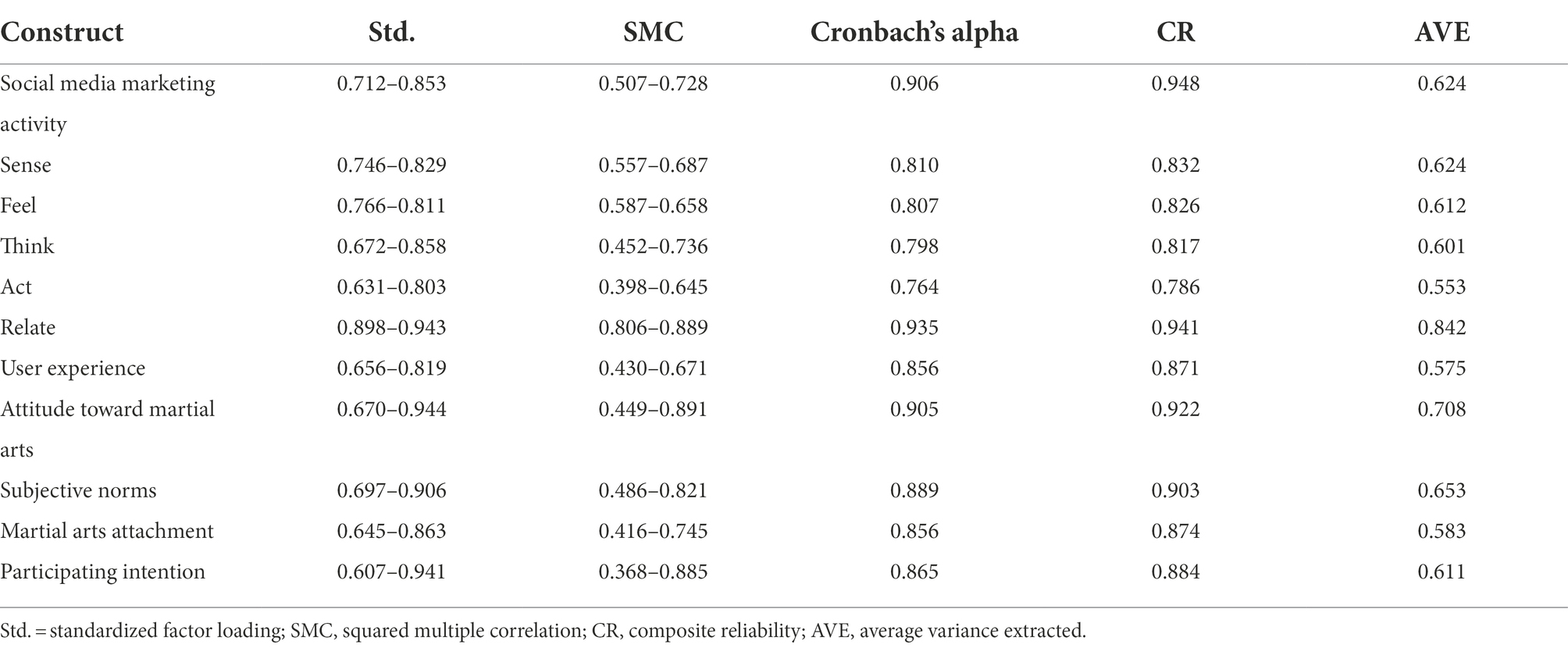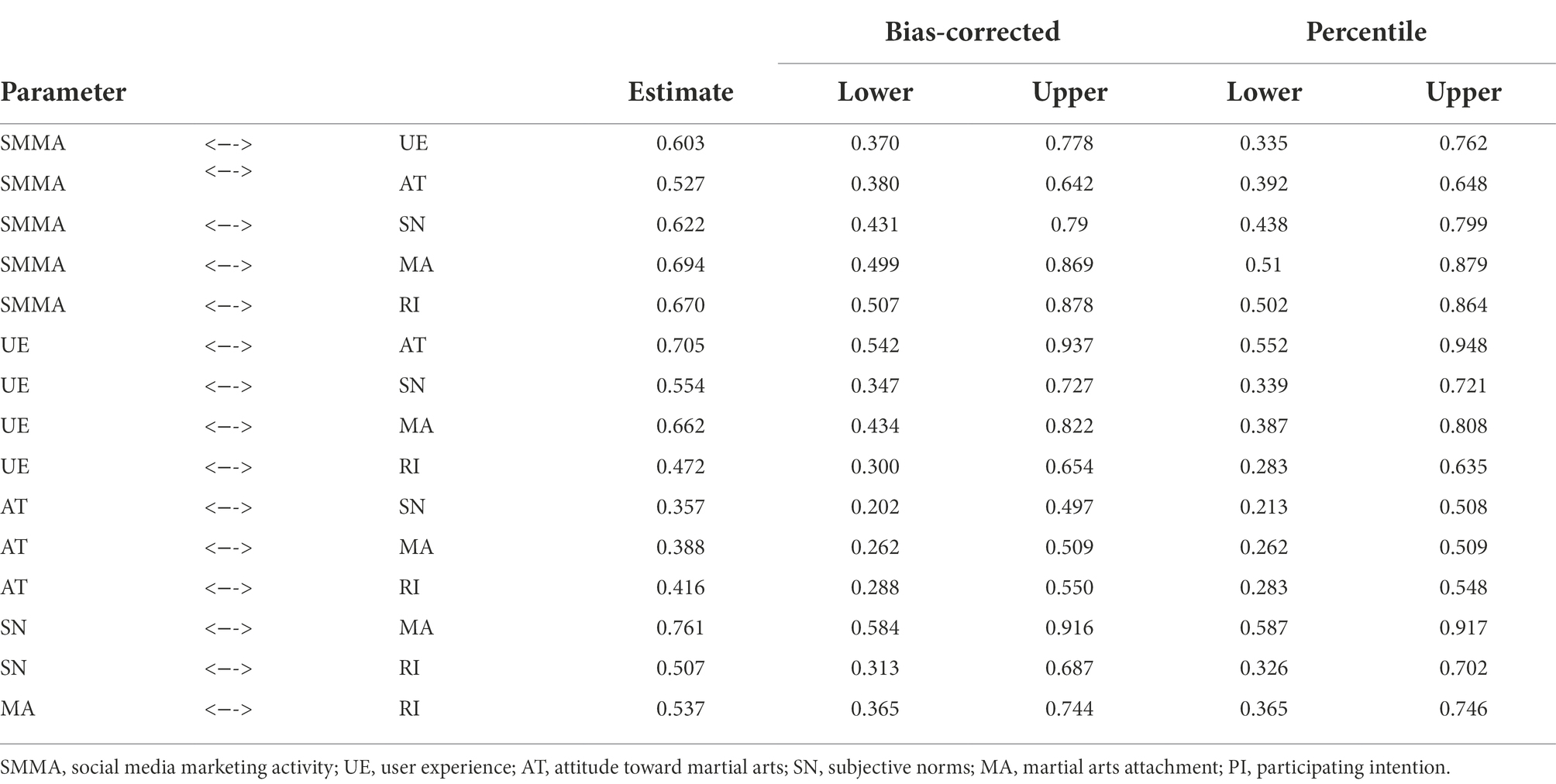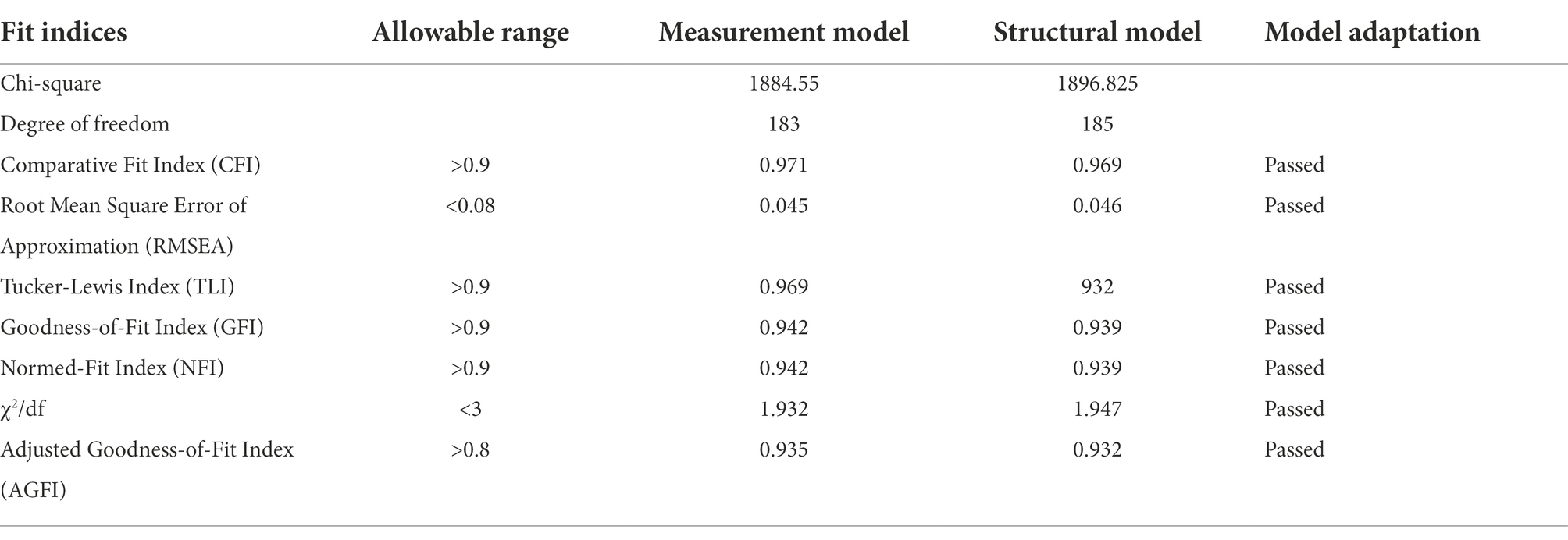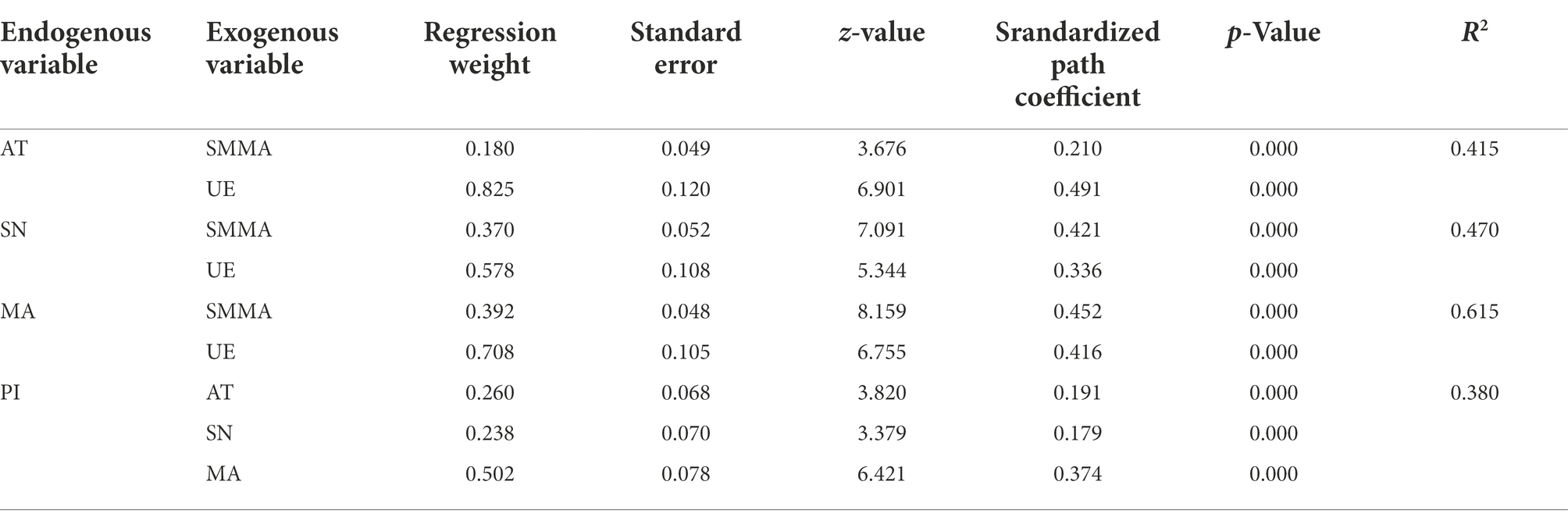- 1School of Physical Education and Health, Zhaoqing University, Guangdong, China
- 2School of Physical Education, Jimei University, Jimei, China
The development of folk martial arts in China has encountered many obstacles and difficulties in promoting the sport. Although there are many martial arts-related groups on WeChat, the largest social media in China, the interaction is not enthusiastic enough and the participation is too low. The main purpose of this study is to understand the impact of social media marketing activities and user experience on the intention of people to participate in martial arts through a quantitative research method. After the literature study, a research model was developed based on Theory of Planned Behavior (TPB), in which the constructs include social media marketing activities, user experience, attitudes toward martial arts, subjective norms, martial arts attachment, and participation intention. The results of the study illustrated that social media marketing activities and user experience had a positive and significant effect on martial arts attitudes, subjective norms, and martial arts attachment via Structural Equation Modeling (SEM). Martial arts attitudes, subjective norms, and martial arts attachment had a positive and significant effect on the intention to participate. Finally, based on the results of this study, we propose suggestions for social media marketing activities, user experience, martial arts attachment, attitudes toward martial arts, subjective norms, and martial arts participation intentions for martial arts social media operators, martial arts promotion organizations, and subsequent studies.
Introduction
Martial art is a form of physical exercise for fitness, strength, and defense that was created by Chinese ancestors and evolved over a long period of time as the Chinese people lived and battled (Trausch, 2018). The demand for martial arts-related competitions, performances, and the video industry has grown significantly. Martial arts is an educational and recreational part of many families’ lives in China as well as in the west and has become an integral part of cultural physical activity (Sun, 2021). Previous research has shown that the promotion of martial arts in the community seems to be inadequate (Huang and Hong, 2018). For example, Zeng and Yang (2021) examined the factors influencing university students’ participation in martial arts. The study mentioned that martial arts education faces many problems, including the varying quality of instructors, the lack of a strict promotion system, and the low number of channels for learning martial arts, which make the development and promotion of martial arts difficult.
Fortunately, the Chinese community still actively promotes martial arts through the social media WeChat martial arts groups (Peng, 2018). However, there is also a low level of community participation, resulting in ineffective promotion of martial arts (Liu et al., 2020). Mak et al. (2022) used social media to assist martial arts learning through video sharing, teaching material exchange, and teacher-student interaction. In addition, in order to accelerate the entry of specific Chinese martial arts events into the Olympic Games, Han et al. (2021) advocate using social media to promote martial arts events and organize martial arts competitions, so that the international martial arts community can understand Chinese martial arts more clearly and more people from different countries can participate in Chinese martial arts sports. Filo et al. (2015) also made the same claim. Although research has confirmed that social media is an effective channel for marketing and promoting the sport (Hazari, 2018). It is the degree of participation of community members that is the key factor in the success of marketing and promotion (Chung et al., 2016; Bazrkar et al., 2021). In other words, increasing community involvement is an important issue in promoting martial arts. Research confirms that social media marketing activities (Choedon and Lee, 2020), user experience (Khan, 2022), sport attachment (Dalangin et al., 2020), and the attitudes and subjective norms of the theory of planned behavior (Leung and Jiang, 2018; Majeed et al., 2021) can influence intention to participate in, purchase, etc.
Also, in Table 1 Measurement items, the subjective norms scale refers to the scale of same variable by Jordan et al. (2018), Bae and Chang (2021), and VG et al. (2021).
In summary, this study aims to increase the participation of martial arts enthusiasts in the martial arts community. In this study, the social media martial arts group members are used as the target population. The effects of social media marketing activities, user experience, martial arts attachment, attitudes toward martial arts, and subjective norms on the intention to participate in the martial arts community will be investigated (Lau and Chen, 2012). Social media marketing activities are the various martial arts information, performances, and competitions that members share or interact with in the social media platform. User experience refers to the extent to which martial arts group members perceive the social media to be enjoyable and easy to use. Martial arts attachment refers to the strength of the emotional connection of martial arts group members to the various martial arts activities of the community. Furthermore, Theory of Planned Behavior (TPB) is a model of behavioral decision making proposed by Ajzen (1985), which consists of the components of behavioral attitudes, subjective norms, perceived behavioral control, and behavioral intention. Through the statistical analysis results, the study hopes to propose practical practices to enhance the participating intention of martial arts community members and provide a reference for social media group operators, martial arts promotion units, and subsequent related studies.
Literature review and research hypotheses
Social media marketing activities
Jong et al. (2021) analyzed how social media use affects work performance. The study mentions that social media can be used to meet people with similar interests, to connect with friends you know, and to meet new friends. In order to better represent the content of social media marketing, scholars have proposed social media marketing activities (Chen and Lin, 2019; Wibowo et al., 2020). Kim and Ko (2012) defined social media marketing activities as activities that aim to promote the understanding of goods on social media. Seo and Park (2018) analyzed the impact of social media marketing activities on user response and brand equity in the aviation industry. The study defines social media marketing activities as a type of advertising on an online platform. In summary, this study defines social media marketing activities as a variety of martial arts marketing activities that involve interacting, collaborating, or sharing content through social media. Ruangkanjanases et al. (2020a) investigated the factors influencing the intention to continue using social media. The study showed that usage satisfaction and perceived usefulness had a positive effect on intention to continue using. Chen et al. (2012) explored several factors that influence the intention to continue using Web 2.0, and found that all the social factors influence the intention to continue using Web 2.0.
Theory of planned behavior
TPB evolved from the theory of reasoned action, which describes and predicts human behavior (Ajzen, 1991). It advocates that attitudes, subjective norms, and perceptual behavioral control act as independent variables that jointly influence behavioral intentions and further influence behavior. Attitude stands for an individual’s negative or positive evaluation of a specific person, event, object, or behavior (Azjen, 1980), and the psychological tendency to express approval or disapproval of a specific behavior (Chen and Hung, 2016). In this study, attitudes toward martial arts were defined as positive or negative evaluations of the marketing and promotional content of the community by martial arts members. The subjective norms are the social pressure experienced by an individual (Ajzen, 1991). Individuals are usually willing to act under the expectations of those who they consider important (Ruangkanjanases et al., 2020b; Chen et al., 2021). In this study, subjective norms were defined as the extent to which members of the martial arts community support their participation in social media by those who they consider important. Behavioral intention is the likelihood of engaging in a specific behavior (Fishbein et al., 1980), and the personal negative or positive feelings about performing the specific behavior (Davis, 1989). In this study, the intention to participate in martial arts was defined as the likelihood that members of the martial arts community would engage in the marketing and promotion of the content.
Sun and Wang (2019) investigated the relationship between social media marketing on product attitudes, subjective norms, and purchase intention. The results indicate that social media marketing positively and significantly affects attitudes and subjective norms towards products. Similar results were found in Cheunkamon et al. (2020). Based on the above studies, this study proposes hypotheses H1 and H2.
H1: Social media marketing activities will have a positive and significant effect on attitudes toward martial arts.
H2: Social media marketing activities will have a positive and significant effect on subjective norms.
Martial arts attachment
In the study of product purchase intention, product attachment is defined as the intensity of the connection between consumers and brands (Park et al., 2014). Based on the above study, this study defines martial arts attachment as the strength of emotional attachment to martial arts of social media members. VanMeter et al. (2018) examined how marketers can increase consumer attachment to brands through social media marketing. The results indicate that social media marketing affects consumers’ attachment to the brand. Based on the above study, this study proposes hypothesis H3 as follows.
H3: Social media marketing activities will have a positive and significant effect on martial arts attachment.
User experience
User experience is the personal perception and responses in the process of using a service (Jang and Han, 2022), the extent to which users have an emotional and cognitive impact (Röttger et al., 2017; Wibowo et al., 2020). This study defines user experience as the extent to which users perceive the martial arts community to be enjoyable and easy to use. Chang and Lin (2015) used customers of creative companies in Taiwan as the target population and showed that customer experience positively influences attitudes and subjective norms. Anshu et al. (2022) used online shopping consumers as the experimental subjects, and the results indicated that shopping attitude would be positively and significantly affected. In summary, this study proposes hypotheses H4 and H5 that user experience will influence attitudes toward martial arts and subjective norms.
H4: User experience will have a positive and significant effect on attitudes toward martial arts.
H5: User experience will have a positive and significant effect on subjective norms.
Tsai (2016) investigated the relationship between travel experience, place attachment, and behavioral intention to consume local food among Taiwanese travelers. The results showed that the local travel experience positively influenced their local attachment. Vada et al. (2019) analyzed whether travel experience and hedonic well-being could influence travelers’ place attachment. The results showed that travel experience affects their place attachment. Based on the above study, hypothesis H6 is proposed in this study.
H6: User experience will have a positive and significant effect on martial arts attachment.
Kim and Kim (2021) investigated the effect of attitude and subjective norms on members’ intention to continue participating in a fencing club in South Korea. The results indicated that attitudes and subjective norms had a positive and significant effect on the intention to continue participation. Similar results have been found in some other studies (Huang et al., 2022). Based on the above studies, this study proposes hypotheses H7 and H8.
H7: Attitudes toward Martial arts will have a positive and significant effect on participating intention.
H8: Subjective norms will have a positive and significant effect on participating intention.
Jin et al. (2020) investigated the decision-making process of travelers’ participation in Guilin, China, and they also investigated the effect of place attachment and impression of tourist places on revisit intention. Prior research found that place attachment had a positive and significant effect on revisit intention (Jin et al., 2020). Petravičiūtė et al. (2021) used Lithuanian online visitors as the target population, and this study also investigated the effect of luxury brand attachment on purchase intention and found that luxury brand attachment affects purchase intention. Based on the above study, this study proposes hypothesis H9 as follows.
H9: Martial attachment will have a positive and significant effect on participating intention.
Research framework
The main purpose of this study is to determine the intention to participate in martial arts. The social media marketing activities and user experience are the independent variables, and martial arts attachment, attitudes toward martial arts, and subjective norms are the mediating variables to investigate their effects on the intention to participate in martial arts. The structure of this study was developed from the literature review as shown in Figure 1.
Methods
Research subjects and data collection
This study investigated the factors influencing the intention to participate in martial arts, and the target population was the members of the martial arts group in WeChat, China. An online electronic questionnaire was distributed for data-gathering. A total of 462 questionnaires were collected during the period of 1 May 2022, to 5 May 2022. After removing the invalid questionnaires, the total of valid ones was 451. Based on the proposed formula for sample size requirements in Petravičiūtė et al. (2021), the total number of people interested in martial arts was 384 with a statistical confidence level of 95% and a confidence interval of 5%.
Measurement scales
This study’s structural framework includes six constructs and the scales. The scales consisted of two sections. Section one collected demographic data, including gender, age, and education level. Section two employed a nominal five-point Likert scale (ranging from 1 “strongly disagree” to 5 “strongly agree”) to collect participants’ opinions on the six variables. Participants answered the survey questions according to their self-perception. Professional scholars were invited to review and comment on the questionnaire items after the scale design. The scales and measurement items are shown as Table 1.
Research method
This study used the questionnaire survey method. The validated samples were analyzed by SPSS 23.0, and descriptive statistics and inferential statistics were examined. The data analysis methods included (1) Frequency distribution: the frequency distribution and percentage of gender, age, and educational level of the sample; (2) Construct validity analysis: The standardized factor loading of confirmatory factor analysis was used to examine the reliability of the questions and constructs. The average variance extracted was used to examine the convergent validity of all constructs. The square roots of average variance extracted were used to compare the correlation coefficients between the constructs to check the discriminant validity between the constructs; (3) Structural equation model testing: including the model fit testing and the hypotheses testing between the constructs through path analysis.
Data analysis
Descriptive analysis
The target population of this study was members of the Chinese WeChat martial arts community. There were 451 valid samples. In terms of gender, most of the members were male, with a total of 267 participants accounting for 59.2%. In terms of age, most of the members were 31–40 years old, with a total of 268 participants accounting for 59.4%. In terms of education level, the majority were university students, with a total of 222 participants accounting for 49.2%, as shown in Table 2.
Construct reliability and validity
Cronbach’s alpha is a widely used measure of the reliability of a survey instrument, which is acceptable at a range of 0.7 or above (Nunnally, 1994). As shown in Table 3, the standardized factor loadings of each scale in this study were greater than 0.6, and the reliability of all constructs was greater than 0.7. And, the values of Cronbach’s alpha and composite reliability of all constructs are greater than 0.7. It can be concluded that all constructs in this study have met reliability. Moreover, all average variance extracted were greater than the value of 0.5 suggested by Hair et al. (1998).
This study adopted bootstrapping method to evaluate the 95% confidence intervals of the correlations of different constructs as a basis for judgement (Torkzadeh et al., 2003), and none of the 95% confidence intervals include 1, indicating the acceptance of discriminant validity between the constructs (as shown in Table 4). Therefore, the results demonstrate that the proposed model has the sufficient discriminant validity.
Structural model inspection
In this study, all nine fitness indicators are within the tolerable range, indicating that the agreement between the predicted and actual observed values of the model in this study is acceptable (Table 5).
As shown in Table 6, Hypothesis 1, the standardized path coefficient of social media marketing activity on attitude toward martial arts is 0.210 (p = < 0.001), so H1 is supported. Hypothesis 2, the standardized regression coefficient of social media marketing activity on subjective norms is 0.421 (p < 0.001), so H2 is accepted. Hypothesis 3, the path coefficient of social media marketing activity on martial arts attachment is 0.452 (p < 0.001), so H3 is verified. Hypothesis 4, the standardized regression coefficient of user experience on attitude toward martial arts is 0.491 (p < 0.001), so H4 is supported. Hypothesis 5, the path coefficient of user experience on subjective norms is 0.336 (p < 0.001), so H5 is accepted. Hypothesis 6, the standardized regression coefficient of user experience on martial arts attachment is 0.416 (p < 0.001), so H6 is accepted. Hypothesis 7, the standardized path coefficient of attitude toward martial arts on participating intention is 0.191 (p < 0.001), so H7 is verified. Hypothesis 8, the standardized path coefficient of subjective norms on participating intention is 0.179 (p < 0.001), so H8 is supported. Hypothesis 9, the standardized path coefficient of martial arts attachment to participating intention is 0.374 (p < 0.001), so H9 is accepted.
Results and discussion
Academic findings and contributions
After empirical analysis, the results of this study verified that social media marketing activities have positive and significant effects on attitudes toward martial arts, subjective norms, and martial arts attachment. These three direct effects were found to be consistent with previous studies VanMeter et al. (2018), Sun and Wang (2019), and Bi et al. (2021), respectively. In other words, the content of various martial arts promotion and marketing activities shared through the interaction of the martial arts social media groups will positively affect the evaluation of martial arts by the group members. The extent to which members consider important people support their participation in social media activities, and the strength of their emotional connection to the marketing and promotional content of the community.
Second, the results also validated that user experience had a positive and significant effect on subjective norms, martial arts attachment, and attitudes toward martial arts. The first two direct effects were found to be consistent with the results of previous studies Chang and Lin (2015) and Vada et al. (2019), respectively. That is the users’ enjoyment and ease of use of the martial arts community. Such a high level of emotional awareness positively influences the extent to which members consider important people to support their participation in social media activities. Members’ emotional connection to the marketing and promotional content of the community is strengthened.
Furthermore, the results validated that attitudes toward martial arts, subjective norms, and martial arts attachment all had positive and significant effects on the intention to participate in martial arts. These three direct effects were found to be consistent with the results of previous research on the TPB, Kim and Kim (2021), Huang et al. (2022), and attachment-related research, Jin et al. (2020), respectively. In other words, martial arts group members’ evaluation of martial arts, the extent to which members consider important people to support their participation in social media activities, and the strength of their emotional connection to the marketing and promotional content of the community positively influenced their intention to participate in martial arts.
Managerial and practical implications
We propose practical suggestions based on direct hypotheses of social media marketing activities to improve their effectiveness as follows. First, social content should incorporate interesting or entertaining topics (Wibowo et al., 2020). For example, the social media operators should consider to combine the hottest martial arts movie episodes and martial arts stars into videos or commentaries, and ask members what they think and whether they want to see a sequel. Second, the social media operators should try to ask open-ended questions that stimulate dialogue. For example, what kind of martial arts sport interests you most. Third, organize activities with simple topics with social media users. For example, the social media operators could invite members to vote for martial arts stars so that members can easily participate. Fourth, the social media operators should induce members to invite their friends to group events and give them extra incentives. For example, by referring friends or inviting them to join a martial arts group through an invitation code. When participating in community or physical martial arts competitions or performances, you can get a discount on tickets or receive a participation ticket.
Based on the direct hypothesis findings of user experience and research which points out user experience of social media can be enhanced through videos, pictures, and emotional sharing (Koetz, 2018), this study proposes the following practical suggestions to enhance the user experience of the martial arts community. First, the live streaming of martial arts competitions, teaching and performances gives group members the opportunity to comment and interact directly with the host in real time. In addition, this will also increase the curiosity of the members about the content of the live broadcast, thus increasing their experience and participation. Second, enhance the photo experience of martial arts community members. For example, create highly visually appealing martial arts or interesting martial arts storyline GIFs. Third, create content that touches the emotions of martial arts community members. For example, the growth stories of famous martial arts stars and athletes or their difficult training process.
Research limitations and future works
This study has some limitations. First, the study was conducted with a sample of Chinese WeChat martial arts group members, and no comparative or differential analysis of other social media was conducted. For example, Weibo, Little Red Book, and Douyin. In other words, the future study must include members of different social media martial arts groups. In addition, the status of martial arts community members may affect their willingness to fill out the questionnaire, e.g., group administrators and members who are more frequently involved in group activities are more willing to fill out the questionnaire. This may affect the validity of the results. Moreover, other factors that affect the intention to participate in martial arts can be included in the future. This will further improve the model to understand the effect of other factors and social media on participation intention. Lastly, this study was conducted only on Chinese martial arts community users. In the future, we can explore the participation of people in different countries and explore the intention to participate in martial arts from a national and regional perspective.
Data availability statement
The raw data supporting the conclusions of this article will be made available by the authors, without undue reservation.
Author contributions
M-CX, Y-CC, and C-MC: conceptualization. M-CX and Y-CC: data curation. M-CX and Y-CC: formal analysis. Y-CC and C-MC: investigation. All authors have read and agreed to the published version of the manuscript.
Conflict of interest
The authors declare that the research was conducted in the absence of any commercial or financial relationships that could be construed as a potential conflict of interest.
Publisher’s note
All claims expressed in this article are solely those of the authors and do not necessarily represent those of their affiliated organizations, or those of the publisher, the editors and the reviewers. Any product that may be evaluated in this article, or claim that may be made by its manufacturer, is not guaranteed or endorsed by the publisher.
References
Ajzen, I. (1985). “From intentions to actions: a theory of planned behavior,” in Action control (New York: Springer), 11–39. doi: 10.1007/978-3-642-69746-3_2
Ajzen, I. (1991). The theory of planned behavior. Organ. Behav. Hum. Decis. Process. 50, 179–211. doi: 10.1016/0749-5978(91)90020-T
Alić, D., Kajmović, H., and Kapo, S. (2014). Differences in attitudes towards combat sports between male and female primary school pupils. Homo Sporticus 16, 21–27.
Anshu, K., Gaur, L., and Singh, G. (2022). Impact of customer experience on attitude and repurchase intention in online grocery retailing: a moderation mechanism of value co-creation. J. Retail. Consum. Serv. 64:102798. doi: 10.1016/j.jretconser.2021.102798
Azjen, I. (1980). Understanding Attitudes and Predicting Social Behavior. Englewood Cliffs, NJ: Prentice Hall.
Bae, S. Y., and Chang, P.-J. (2021). The effect of coronavirus disease-19 (COVID-19) risk perception on behavioural intention towards ‘untact’tourism in South Korea during the first wave of the pandemic (March 2020). Curr. Issue Tour. 24, 1017–1035. doi: 10.1080/13683500.2020.1798895
Bazrkar, A., Hajimohammadi, M., Aramoon, E., and Aramoon, V. (2021). Effect of the social media marketing strategy on customer participation intention in light of the mediating role of customer perceived value. Market-Tržište 33, 41–58. doi: 10.22598/mt/2021.33.1.41
Bi, N. C., Lu, Y., Ha, L., and Chen, P. (2021). Attitude change toward the Chinese during the US-China trade conflict: examining the roles of social media news sharing and perceived news feed performance. Online Inf. Rev. 45, 599–613. doi: 10.1108/OIR-05-2020-0178
Chang, S.-H., and Lin, R. (2015). Building a total customer experience model: applications for the travel experiences in Taiwan’s creative life industry. J. Travel Tour. Mark. 32, 438–453. doi: 10.1080/10548408.2014.908158
Chen, S.-C., and Hung, C.-W. (2016). Elucidating the factors influencing the acceptance of green products: an extension of theory of planned behavior. Technol. Forecast. Soc. Chang. 112, 155–163. doi: 10.1016/j.techfore.2016.08.022
Chen, S.-C., Jong, D., Hsu, C.-S., and Lin, C.-H. (2021). Understanding extended theory of planned behavior to access backpackers’ intention in self-service travel websites. J. Hosp. Tour. Res. :1096348021994166. doi: 10.1177/1096348021994166
Chen, S.-C., and Lin, C.-P. (2015). The impact of customer experience and perceived value on sustainable social relationship in blogs: an empirical study. Technol. Forecast. Soc. Chang. 96, 40–50. doi: 10.1016/j.techfore.2014.11.011
Chen, S.-C., and Lin, C.-P. (2019). Understanding the effect of social media marketing activities: the mediation of social identification, perceived value, and satisfaction. Technol. Forecast. Soc. Chang. 140, 22–32. doi: 10.1016/j.techfore.2018.11.025
Chen, S.-C., Yen, D. C., and Hwang, M. I. (2012). Factors influencing the continuance intention to the usage of web 2.0: an empirical study. Comput. Hum. Behav. 28, 933–941. doi: 10.1016/j.chb.2011.12.014
Cheunkamon, E., Jomnonkwao, S., and Ratanavaraha, V. (2020). Determinant factors influencing Thai tourists’ intentions to use social media for travel planning. Sustainability 12:7252. doi: 10.3390/su12187252
Choedon, T., and Lee, Y.-C. (2020). The effect of social media marketing activities on purchase intention with brand equity and social brand engagement: empirical evidence from Korean cosmetic firms. Knowl. Manag. Res. 21, 141–160. doi: 10.15813/kmr.2020.21.3.008
Chung, T.-L. D., Anaza, N. A., Park, J., and Hall-Phillips, A. (2016). Who’s behind the screen? Segmenting social venture consumers through social media usage. J. Retail. Consum. Serv. 28, 288–295. doi: 10.1016/j.jretconser.2015.01.006
Dalangin, J. J. G., Pascua, L. L., Aquino, R. J., and Cereno, E. P. (2020). Mediating the sport con-sumer behaviour model: analysis in non-sporting brand. J. Stud. Komunikasi 4, 282–295. doi: 10.25139/jsk.v4i2.2386
Davis, F. D. (1989). Perceived usefulness, perceived ease of use, and user acceptance of information technology. MIS Q. 13, 319–340. doi: 10.2307/249008
Ebrahim, R. S. (2020). The role of trust in understanding the impact of social media marketing on brand equity and brand loyalty. J. Relatsh. Mark. 19, 287–308. doi: 10.1080/15332667.2019.1705742
Filo, K., Lock, D., and Karg, A. (2015). Sport and social media research: a review. Sport Manag. Rev. 18, 166–181. doi: 10.1016/j.smr.2014.11.001
Fishbein, M., Jaccard, J., Davidson, A. R., Ajzen, I., and Loken, B. (1980). “Predicting and understanding family planning behaviors,” in Understanding Attitudes and Predicting Social Behavior. ed. I. Azjen (Englewood Cliffs, NJ: Prentice Hall)
Han, Q.-S., Theeboom, M., and Zhu, D. (2021). Chinese martial arts and the Olympics: analysing the policy of the International Wushu Federation. Int. Rev. Sociol. Sport 56, 603–624. doi: 10.1177/1012690220957177
Hair, J. F., Black, W. C., Babin, B. J., Anderson, R. E., and Tatham, R. L. (1998). Multivariate Data Analysis. (Prentice Hall, Upper Saddle River) Vol. 5, 207–219.
Hazari, S. (2018). Investigating social media consumption, sports enthusiasm, and gender on sponsorship outcomes in the context of Rio Olympics. Int. J. Sports Mark. Spons. 19, 396–414. doi: 10.1108/IJSMS-01-2017-0007
Hsu, H. Y., and Tsou, H.-T. (2011). Understanding customer experiences in online blog environ-ments. Int. J. Inf. Manag. 31, 510–523. doi: 10.1016/j.ijinfomgt.2011.05.003
Huang, F., and Hong, F. (2018). A History of Chinese Martial Arts: Research Institute of Martial Arts, Ministry of Sport of China, New York: Routledge, doi: 10.4324/9781315628073
Huang, H., Wei, J., and Yang, R. (2022). Determinants of consumers’ intention to participate in automobile recalls for environmental defects: using an extended theory of planned behavior. J. Environ. Plan. Manag. 65, 1–20. doi: 10.1080/09640568.2022.2062566
Hwang, E., Baloglu, S., and Tanford, S. (2019). Building loyalty through reward programs: the influence of perceptions of fairness and brand attachment. Int. J. Hosp. Manag. 76, 19–28. doi: 10.1016/j.ijhm.2018.03.009
Jang, H., and Han, S. H. (2022). User experience framework for understanding user experience in blockchain services. Int. J. Hum.-Comp. Stud. 158:102733. doi: 10.1016/j.ijhcs.2021.102733
Jin, M.-I., Choi, Y., Lee, C.-K., and Ahmad, M. S. (2020). Effects of place attachment and image on revisit intention in an ecotourism destination: using an extended model of goal-directed behavior. Sustainability 12:7831. doi: 10.3390/su12187831
Jong, D., Chen, S.-C., Ruangkanjanases, A., and Chang, Y.-H. (2021). The impact of social media usage on work efficiency: the perspectives of media synchronicity and gratifications. Front. Psychol. 12:693183, doi: 10.3389/fpsyg.2021.693183
Jordan, E. J., Bynum Boley, B., Knollenberg, W., and Kline, C. (2018). Predictors of intention to travel to Cuba across three time horizons: an application of the theory of planned behavior. J. Travel Res. 57, 981–993. doi: 10.1177/0047287517721370
Khan, I. (2022). Do brands’ social media marketing activities matter? A moderation analysis. J. Retail. Consum. Serv. 64:102794. doi: 10.1016/j.jretconser.2021.102794
Kim, Y.-J., and Kim, E.-S. (2021). Analysis of Korean fencing club members’ participation intention using the TPB model. Int. J. Environ. Res. Public Health 18:2813. doi: 10.3390/ijerph18062813
Kim, A. J., and Ko, E. (2012). Do social media marketing activities enhance customer equity? An empirical study of luxury fashion brand. J. Bus. Res. 65, 1480–1486. doi: 10.1016/j.jbusres.2011.10.014
Koetz, C. (2018). Managing the customer experience: a beauty retailer deploys all tactics. J. Bus. Strateg. 40, 10–17. doi: 10.1108/JBS-09-2017-0139
Lau, C. M., and Chen, Q. (2012). Modeling participation intention of adults in continuing education: a behavioral approach. Int. Educ. Stud. 5, 161–177. doi: 10.5539/ies.v5n3p161
Leung, X. Y., and Jiang, L. (2018). How do destination Facebook pages work? An extended TPB model of fans’ visit intention. J. Hosp. Tour. Technol. 9, 397–416. doi: 10.1108/JHTT-09-2017-0088
Lin, H.-F. (2006). Understanding behavioral intention to participate in virtual communities. Cyberpsychol. Behav. 9, 540–547. doi: 10.1089/cpb.2006.9.540
Liu, W. D., Yan, S. L., Ma, H. H., and Zhang, G. D. (2020). Current situation and countermeasures of traditional martial arts Wechat public account. Youth Journalist 23, 102–103.
Majeed, M., Owusu-Ansah, M., and Ashmond, A.-A. (2021). The influence of social media on purchase intention: the mediating role of brand equity. Cogent Bus. Manag. 8:1944008. doi: 10.1080/23311975.2021.1944008
Mak, M. Y. C., Poon, A. Y. M., and Chiu, D. K. (2022). “Using social media as learning aids and preservation: Chinese martial arts in Hong Kong,” in In the digital folklore of Cyberculture and digital humanities (Hershey, PA: IGI Global), 171–185.
Park, C. W., Priester, J. R., MacInnis, D. J., and Wan, Z. (2014). The Connection-Prominence Attachment Model (CPAM): A Conceptual and Methodological Exploration of Brand Attachment. In Handbook of Brand Relationships (pp. 349–363). New York: Routledge.
Peng, Z. (2018). Analysis on the Value of Network Media in Martial Arts Communication. 8th International Conference on Social Network, Communication and Education (SNCE 2018).
Petravičiūtė, K., Šeinauskiené, B., Rūtelionė, A., and Krukowski, K. (2021). Linking luxury brand perceived value, brand attachment, and purchase intention: the role of consumer vanity. Sustainability 13:6912. doi: 10.3390/su13126912
Röttger, S., Maier, J., Krex-Brinkmann, L., Kowalski, J. T., Krick, A., Felfe, J., et al. (2017). Social cognitive aspects of the participation in workplace health promotion as revealed by the theory of planned behavior. Prev. Med. 105, 104–108. doi: 10.1016/j.ypmed.2017.09.004
Ruangkanjanases, A., Hsu, S.-L., Wu, Y. J., Chen, S.-C., and Chang, J.-Y. (2020a). What drives continuance intention towards social media? Social influence and identity perspectives. Sustainability 12:7081.
Ruangkanjanases, A., You, J.-J., Chien, S.-W., Ma, Y., Chen, S.-C., and Chao, L.-C. (2020b). Elucidating the effect of antecedents on consumers’ green purchase intention: an extension of the theory of planned behavior. Front. Psychol. 11:1433. doi: 10.3389/fpsyg.2020.01433
Seo, E.-J., and Park, J.-W. (2018). A study on the effects of social media marketing activities on brand equity and customer response in the airline industry. J. Air Transp. Manag. 66, 36–41. doi: 10.1016/j.jairtraman.2017.09.014
Sharma, V. M., and Klein, A. (2020). Consumer perceived value, involvement, trust, susceptibility to interpersonal influence, and intention to participate in online group buying. J. Retail. Consum. Serv. 52:101946. doi: 10.1016/j.jretconser.2019.101946
Sun, J. (2021). Review Martial Arts Education in Primary Schools. 2nd International Conference on Education Studies: Experience and Innovation (ICESEI 2021).
Sun, Y., and Wang, S. (2019). Understanding consumers’ intentions to purchase green products in the social media marketing context. Asia Pac. J. Mark. Logist. 32, 860–878. doi: 10.1108/APJML-03-2019-0178
Tasci, A. D., Uslu, A., Stylidis, D., and Woosnam, K. M. (2022). Place-oriented or people-oriented concepts for destination loyalty: destination image and place attachment versus perceived dis-tances and emotional solidarity. J. Travel Res. 61, 430–453. doi: 10.1177/0047287520982377
Torkzadeh, G., Koufteros, X., and Pflughoeft, K. (2003). Confirmatory analysis of computer self-efficacy. Struct. Equ. Model. 10, 263–275. doi: 10.1207/S15328007SEM1002_6
Trausch, T. (2018). Chinese Martial Arts and Media Culture: Global Perspectives. Lanham, MD: Rowman & Littlefield.
Tsai, C. T. (2016). Memorable tourist experiences and place attachment when consuming local food. Int. J. Tour. Res. 18, 536–548. doi: 10.1002/jtr.2070
Vada, S., Prentice, C., and Hsiao, A. (2019). The influence of tourism experience and well-being on place attachment. J. Retail. Consum. Serv. 47, 322–330. doi: 10.1016/j.jretconser.2018.12.007
VanMeter, R., Syrdal, H. A., Powell-Mantel, S., Grisaffe, D. B., and Nesson, E. T. (2018). Don’t just “like” me, promote me: how attachment and attitude influence brand related behaviors on social media. J. Interact. Mark. 43, 83–97. doi: 10.1016/j.intmar.2018.03.003
VG, G., Park, E., and Lee, C. K. (2021). Testing the influence of destination source credibility, destination image, and destination fascination on the decision-making process: case of the Cayman Islands. Int. J. Tour. Res. 23, 569–580. doi: 10.1002/jtr.2427
Wibowo, A., Chen, S.-C., Wiangin, U., Ma, Y., and Ruangkanjanases, A. (2020). Customer behavior as an outcome of social media marketing: the role of social media marketing activity and customer experience. Sustainability 13:189. doi: 10.3390/su13010189
Yang, C.-C., Liu, L.-W., Lin, Y.-S., Lin, C.-T., and Chang, Y.-N. (2020). The impact on sports internet celebrity’s video watching behavior to sports attitudes and sports behaviors. Talent. Dev. Excell. 12, 1731–1741.
Keywords: social media, user experience, attitudes toward martial arts, martial arts attachment, theory of planned behavior
Citation: Xie M-C, Chang Y-C and Cai C-M (2022) Understanding the effect of social media marketing activity for promoting intention to participate in martial arts. Front. Psychol. 13:999153. doi: 10.3389/fpsyg.2022.999153
Edited by:
Shih-Chih Chen, National Kaohsiung University of Science and Technology, TaiwanReviewed by:
Maosheng Yang, Renmin University of China, ChinaChin-Jung Wu, National Pingtung University, Taiwan
Copyright © 2022 Xie, Chang and Cai. This is an open-access article distributed under the terms of the Creative Commons Attribution License (CC BY). The use, distribution or reproduction in other forums is permitted, provided the original author(s) and the copyright owner(s) are credited and that the original publication in this journal is cited, in accordance with accepted academic practice. No use, distribution or reproduction is permitted which does not comply with these terms.
*Correspondence: Chuan-Ming Cai, MjkyMDkwMTQ2NUBxcS5jb20=
 Ming-Chuan Xie1
Ming-Chuan Xie1 Chuan-Ming Cai
Chuan-Ming Cai